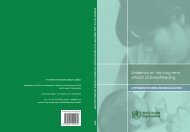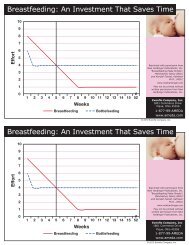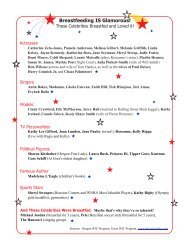Going home protocol - Breastfeeding Made Simple
Going home protocol - Breastfeeding Made Simple
Going home protocol - Breastfeeding Made Simple
- No tags were found...
Create successful ePaper yourself
Turn your PDF publications into a flip-book with our unique Google optimized e-Paper software.
The Academy Of <strong>Breastfeeding</strong> MedicineABM ProtocolsA central goal of The Academy of <strong>Breastfeeding</strong> Medicine is the developmentof clinical <strong>protocol</strong>s for managing common medical problems that may impactbreastfeeding success. These <strong>protocol</strong>s serve only as guidelines for the care ofbreastfeeding mothers and infants and do not delineate an exclusive course oftreatment or serve as standards of medical care. Variations in treatment may beappropriate according to the needs of an individual patient.Protocol #2: Guidelines for hospital discharge of thebreastfeeding term newborn and mother:“<strong>Going</strong> <strong>home</strong> <strong>protocol</strong>”BACKGROUNDThe ultimate success of breastfeeding is measured in the duration of breastfeeding and of exclusivebreastfeeding, not solely in the initiation of breastfeeding. Anticipatory attention to the needs of the motherand baby at the time of discharge from the hospital is crucial to ensure successful, long-term breastfeeding.The following principles and practices are recommended for consideration prior to sending a mother andher full-term infant <strong>home</strong>.GUIDELINES1. Formal documented assessment of breastfeeding effectiveness should be performed at least once duringthe last 8 hours preceding discharge of the mother and baby by a medical professional trained in formalassessment of breastfeeding (in addition to similar assessments performed earlier in the hospitalization).This should include evaluation of positioning, latch, milk transfer, baby’s weight, clinical jaundice, and allproblems raised by the mother, such as nipple pain or perception of inadequate supply.2. All problems with breastfeeding, whether observed by hospital staff or raised by the mother, should beattended to and documented in the medical record prior to discharge of mother and baby, with a plan ofaction that includes follow- up of the problem after discharge. 13. Physicians, nurses, and all other staff should encourage the mother to practice exclusive breastfeedingfor the first 6 months of the infant’s life and to continue breastfeeding until 1 year of age and beyond, withthe addition of complementary food after 6 months of life. 2 Mothers will benefit from education about therationale for exclusive breastfeeding and why artificial milk supplementation is discouraged. Sucheducation is a regular component of anticipatory guidance that addresses individual beliefs and practices ina culturally sensitive manner. Special counseling is needed for those mothers planning to return to outsideemployment or school.4. Families will benefit from appropriate, noncommercial educational materials on breastfeeding (as well ason other aspects of child health care). 3 Discharge packs containing infant formula, pacifiers, commercialadvertising materials, and any materials not appropriate for a breastfeeding mother and baby should not bedistributed. 2,4–85. <strong>Breastfeeding</strong> mothers and appropriate others will benefit from anticipatory guidance prior to dischargeregarding the next month of breastfeeding (e.g., guidance for engorgement, growth spurts, diminished milk
supply). Specific guidance should be provided in written form to all parents regarding assessment of (a)adequacy of stool and urine output, (b) jaundice, and (c) sleep and feeding patterns.6. Every breastfeeding mother should receive instruction on techniques for expression of milk by hand orby pump so that she can maintain her milk supply and obtain milk for feeding to the infant should she andthe infant be separated or the infant be unable to feed directly from thebreast. 97. Every breastfeeding mother should be provided with names and phone numbers of individuals andmedical services that can provide advice, counseling, and health assessments related to breastfeeding on a24 hour-a-day basis, as well as on a less intensive basis. 1,5,10–128. Mothers should be provided with lists of various peer support groups (e.g., La Leche LeagueInternational) with phone numbers and addresses and encouraged to contact and consider joining one ofthese groups. 13,149. Prior to discharge, appointments should be made for (a) an office or <strong>home</strong> visit, within 2 to 3 days, by aphysician or a physician-supervised breastfeeding-trained licensed health care provider (infants dischargedbefore 48 hours of age should be seen by 2 to 4 days of age), and (b) the mother’s 6-week follow-up visit tothe obstetrician or family physician. Additional visits for the mother and infant are recommended until allclinical issues are resolved (e.g., weight gain is well established, jaundice resolving). A routine preventivecare visit should occur when the child is 2 to 4 weeks of age. 2,11,12,15,1610. If the mother is medically ready for discharge but the infant is not, every effort should be made to allowthe mother to remain in the hospital either as a continuing patient or as a “mother-in-residence” with accessto the infant for exclusive breastfeeding. Maintenance of a 24-hour rooming-in relationship with the infantis optimal during the infant’s extended stay. 17–2111. If the mother is discharged from the hospital before the infant is discharged (as in the case of a sickinfant), the mother should be encouraged to spend as much time as possible with the infant and to continueregular breastfeeding. 22 During periods when the mother is not in the hospital, she should be encouraged toexpress and store her milk, bringing it to the hospital for the infant.REFERENCES1. Kuan LW, Britto M, Decolongon J, et al: Health system factors contributing to breastfeeding success.Pediatrics 104: 28, 1999.2. The American Academy of Pediatrics, Work Group on <strong>Breastfeeding</strong>: <strong>Breastfeeding</strong> and the use ofhuman milk. Pediatrics 100:1035–1039, 1997.3. Valaitis RK, Shea E: An evaluation of breastfeeding promotion literature: Does it really promotebreastfeeding? Can J Public Health 84:24–27, 1993.4. Dungy CI, Christensen-Szalanski J, Losch M, Russell D: Effect of discharge samples on duration ofbreast-feeding. Pediatrics 90:233–237, 1992.5. Frank DA, Wirtz SJ, Sorenson JR, Heeren T: Commercial discharge packs and breast-feedingcounseling: Effects oninfant-feeding practices in a randomized trial. Pediatrics 80:845–854, 1987.6. Bergevin Y, Dougherty C, Kramer M: Do infant formula samples shorten the duration of breast-feeding?Lancet 1(8334): 1148–1151, 1983.7. Perez-Escamilla R, Pollitt E, Lonnerdal B, Dewey KG: Infant feeding policies in maternity wards andtheir effect onbreast-feeding success: An analytical overview. Am J Public Health 84:89–97, 1994.8. Aarts C, Hornell A, Kylberg E, Hofvander Y, Gebre-Medhin M: <strong>Breastfeeding</strong> patterns in relation tothumb sucking and pacifier use. Pediatrics 104:50, 1999.9. World Health Organization, United Nations Children’s Fund. Protecting, promoting and supportingbreastfeeding: The special role of maternity services (A joint WHO/UNICEF statement). Int J GynaecolObstet 31:171–183, 1990.10. Bloom K, Goldbloom RB, Robinson SC, Stevens FE: Breast versus formula feeding. Acta PaediatrScand Suppl 300:1–26, 1982.11. Chen CH: Effects of <strong>home</strong> visits and telephone contacts on breastfeeding compliance in Taiwan.Matern Child Nurs J21:82–90, 1993.12. Houston MJ, Howie PW, Cook A, McNeilly AS: Do breastfeeding mothers get the <strong>home</strong> support theyneed? Health Bull (Edinb) 39:166–172, 1981.13. Long DG, Funk-Archuleta MA, Geiger CJ, Mozar AJ, Heins JN: Peer counselor program increasesbreastfeeding rates in Utah Native American WIC population. J Hum Lact 11:279–284, 1995.
14. Kistin N, Abramson R, Dublin P. Effect of peer counselors on breastfeeding initiation, exclusivity, andduration among low-income urban women. J Hum Lact 10:11–15, 1994.15. Jenner S: The influence of additional information, advice and support on the success of breast feedingin working class primiparas. Child Care, Health Dev 14:319–328, 1988.16. Jones DA, West RR: Effect of a lactation nurse on the success of breast-feeding: A randomizedcontrolled trial. J Epidemiol Community Health 40:45–49, 1986.17. Waldenstrom U, Swenson A: Rooming-in at night in the postpartum ward. Midwifery 7:82–89, 1991.18. Yamauchi Y, Yamanouchi I: The relationship between rooming- in/not rooming-in and breast-feedingvariables. Acta Paediatr Scand 79:1017–1022, 1990.19. Keefe MR: The impact of infant rooming-in on maternal sleep at night. J Obstet Gynecol Neonatal Nurs17:122–126, 1988.20. Keefe MR: Comparison of neonatal nighttime sleep-wake patterns in nursery versus rooming-inenvironments. Nurs Res 36:140–144, 1987.21. Procianoy RS, Fernandes-Filho PH, Lazaro L, Sartori NC, Drebes S: The influence of rooming-in onbreastfeeding. J Trop Pediatr 29:112–114, 1983.22. Hurst NM, Valentine CJ, Renfro L, Burns P, Ferlic L: Skin-to-skin holding in the neonatal intensivecare unit influences maternal milk volume. J Perinatol 17:213–217, 1997.








